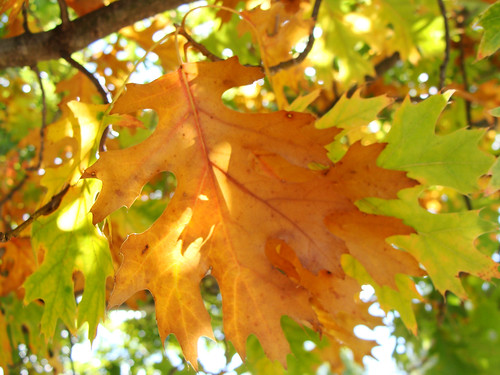Finally: Fall color!
By Sarah Cato
U of A System Division of Agriculture
Oct. 27, 2017
Fast Facts
- Cool temps help slow photosynthesis, a step toward color change
- Weather and daylight both play roles in changes
- Variations in color are seen across Arkansas
(410 words)
(Newsrooms – with downloadable art at www.flickr.com/photos/uacescomm/albums/72157687525686331)
(Download this story in MS Word format here.)
LITTLE ROCK – Finally, it’s fall foliage time.
The 80-degree fall weather this year has kept the leaves in Arkansas green a little longer than past seasons. Tamara Walkingstick, associate director of the Arkansas Forest Resources Center and an extension forester, explained how this year’s weather has played a role in leaf color.
“It’s been so warm, in some places it’s been delayed,” she said. “These warm temperatures keep photosynthesis going. When the cool temperatures came the color change seemed sudden.”
When photosynthesis stops, the chlorophyll breaks down, enabling the leaves’ real colors to show.
“A lot of people think it’s only temperatures, or that the leaves won’t change until it’s cool,” she said “But it’s due to number of hours of daylight. Fewer hours of daylight have caused photosynthesis to stop.”
Walkingstick said the main cause of this change is attributed the amount of daylight to which trees are exposed. The shorter the days, the more the photosynthesis slows.
However, Walkingstick said a short stretch of these lower temperatures helped spark the change in some places.
“I watched a little maple tree in my yard that changed pretty dramatically due to cool temperatures,” she said. “Two nights of cool weather caused the slow of photosynthesis.”
Arkansas is home to many colorful species. Some of the earliest color comes from black gum trees, whose leaves are a vivid red, and sweet gums and maples whose colors vary from yellow to red. The state’s horse chestnuts bring gold to the landscape. Even cypresses get in on the act, their leaves turning rust colored in the fall.
Fall colors may differ across the state. Walkingstick said this is caused by variation in elevation and climate.
“We have so much temperature gradation in the state,” she said. “And in some of the higher elevations some of the oaks have already turned brown.”
Fall’s color was short-lived in some places, thanks to recent storms, which stripped leaves from trees before the colors could fully develop.
“There was color,” she said, “But the wind and rain came through and now it’s gone.”
The Arkansas tourism website offers a fall foliage destination guide that shows the variations of colors in the state. With peak timing of beautiful fall colors across Arkansas, the guide suggests the best roads to take and what time of the year different areas should be visited.
For more information on forestry, contact Walkingstick at 501-671-2346 or twalkingstick@uada.edu.
For more information on the Arkansas self-guided fall foliage tour visit https://www.arkansas.com/travel-tools/seasons/fall/fall-update/
About the Division of Agriculture
The University of Arkansas System Division of Agriculture’s mission is to strengthen agriculture, communities, and families by connecting trusted research to the adoption of best practices. Through the Agricultural Experiment Station and the Cooperative Extension Service, the Division of Agriculture conducts research and extension work within the nation’s historic land grant education system.
The Division of Agriculture is one of 20 entities within the University of Arkansas System. It has offices in all 75 counties in Arkansas and faculty on five system campuses.
Pursuant to 7 CFR § 15.3, the University of Arkansas System Division of Agriculture offers all its Extension and Research programs and services (including employment) without regard to race, color, sex, national origin, religion, age, disability, marital or veteran status, genetic information, sexual preference, pregnancy or any other legally protected status, and is an equal opportunity institution.
# # #
Media Contact: Mary Hightower
Dir. of Communication Services
U of A System Division of Agriculture
Cooperative Extension Service
(501) 671-2126
mhightower@uada.edu
Related Links
